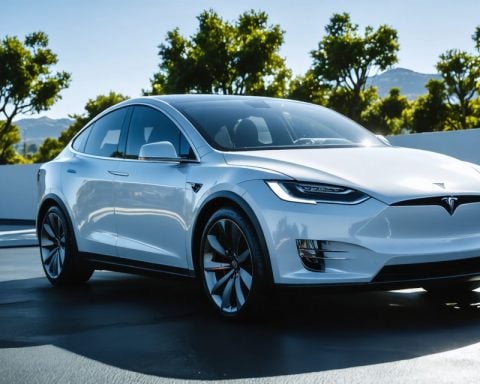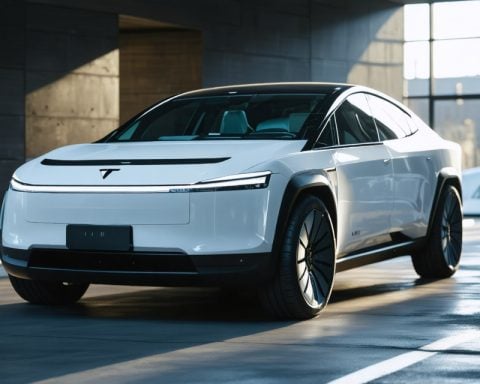- Austin’s main bus depot implements a 2.9 MW fast-charging power system through Camber, enhancing sustainable public transportation.
- Camber installs two 1440 kW charging systems with 48 industrial dispensers, optimizing energy delivery for electric buses.
- Camber, emerging from Proterra’s downfall, brings advanced energy management to CapMetro, reducing costs and ensuring maintenance excellence.
- CapMetro invests $255 million in 197 electric buses, marking the largest procurement of its kind in the U.S., despite economic challenges.
- Infrastructure challenges persist, with on-route charging and depot power being crucial for operational efficiency and uptime.
- CapMetro temporarily pauses 46 electric buses to address technical issues, signaling an ongoing commitment to a seamless electrified future.
- Austin leads the charge towards a sustainable public transit model, setting a precedent for other cities in adopting electric vehicles.
Beneath the sprawling Texas skies, a quiet revolution hums at Austin’s main bus depot. Camber has sparked life into the city’s vision for an electric future by delivering a potent surge of 2.9 megawatts of fast-charging power. This isn’t just an upgrade; it’s a statement of intent and momentum in the march towards sustainable public transportation.
The technical prowess of Camber shines through the installation of two robust 1440 kW charging systems, accompanied by a fleet of 48 industrial dispensers. These high-capacity stations are poised to charge multiple buses simultaneously, injecting the fleet with energy and efficiency.
Born from the remnants of the now-defunct Proterra, Camber emerges as an industrious phoenix, bringing with it a promise of continued maintenance and operational excellence. Its advanced energy management software equips CapMetro to not only shepherd its electric fleet safely but also to optimize energy costs and minimize lifetime expenses.
Austin stands as a beacon for electric vehicle adoption, and CapMetro’s ambitions only underscore that. Despite hurdles like Proterra’s bankruptcy and broader economic challenges, the agency remains undeterred. The monumental $255 million investment in 197 electric buses, a procurement first in size across the United States, is a testament to its steadfast commitment.
Yet, this electric dream isn’t without its challenges. Building an infrastructure capable of supporting such an ambitious rollout is a complicated endeavor. CapMetro’s President, Dottie Watkins, has acknowledged the infrastructure as one of the toughest nuts to crack. The blend of on-route charging capabilities and depot power ensures buses are ever-ready, cutting down on peak demands and enhancing the fleet’s operational uptime.
Indeed, as CapMetro temporarily parks 46 new electric buses to sort out technical kinks, there’s a silver lining—the anticipation of a more seamless, electrified transit experience once the charging infrastructure is robustly in place.
Ultimately, Austin’s journey towards a greener tomorrow signals more than just operational efficiency; it embodies a commitment to community and planet. As other cities watch and learn, Austin is proving that the future of public transit lies not just in moving bodies, but in moving towards a sustainable, smart, and electric frontier.
Austin’s Electric Bus Revolution: What You Need to Know and Why It Matters
The Future of Public Transit in Austin: Camber’s Role and Beyond
Overview of Austin’s Electric Bus Initiative
Under the vast Texas sky, Austin is spearheading an electrifying shift in public transport, thanks to a groundbreaking initiative driven primarily by Camber. This strategic transformation has manifested in the integration of a 2.9-megawatt fast-charging system designed to recharge the city’s growing fleet of electric buses swiftly and efficiently. This marks a significant advancement in Austin’s commitment to sustainability and climate responsibility.
How Camber is Powering Austin’s Electric Fleet
Camber, emerging phoenix-like after Proterra’s bankruptcy, has installed two 1440 kW charging systems alongside 48 industrial dispensers at Austin’s main bus depot. These high-capacity stations enable simultaneous charging of multiple buses, ensuring that the fleet remains operational and efficient. This infrastructure is critical in minimizing energy costs and maintaining a robust, green public transportation system.
The Challenges of Electric Bus Infrastructure
Acknowledging the complexity of developing a capable infrastructure to support such a notable initiative, CapMetro’s President, Dottie Watkins, has pointed to on-route and depot charging capabilities as one of the significant challenges. The infrastructure aims to minimize peak power demands and increase the fleet’s operational uptime, though it faces obstacles like technical kinks that have temporarily sidelined 46 new electric buses.
Real-World Use Cases and Benefits
1. Operational Efficiency: The simultaneous charging capabilities of Camber’s system significantly reduce downtime, enhancing the fleet’s operational efficiency.
2. Cost Optimization: Advanced energy management software helps CapMetro manage and optimize energy consumption and costs.
3. Environmental Impact: Reducing emissions and the city’s carbon footprint aligns with Austin’s broader environmental goals.
Controversies and Limitations
Despite the promising technology, Proterra’s bankruptcy underscores the financial uncertainties facing electric bus manufacturers. This necessitates ongoing vigilance and support to transition to electric smoothly.
Market Forecasts and Industry Trends
With CapMetro’s $255 million investment in 197 electric buses—the largest procurement of its kind in the U.S.—other cities are watching closely. The success in Austin could set a precedent, with increased adoption and infrastructure investment anticipated nationwide.
Pros and Cons Overview
Pros:
– Sustainable transportation solution
– Reduced carbon emissions
– Lower operational costs over time
Cons:
– High initial investment
– Technical difficulties in large-scale deployments
– Requires robust infrastructure development
Actionable Recommendations
– Stay Informed: For residents and stakeholders, staying updated on infrastructure developments and service changes is crucial.
– Support Local Initiatives: Community support can bolster local efforts and funding in sustainable projects.
– Advocate for Expansion: Encourage local governments to consider similar sustainable transportation solutions.
Conclusion and Quick Tips
Austin’s electrification of buses stands as a model for sustainable public transit. As the city continues to address challenges and refine its infrastructure, residents can expect a more efficient and environmentally friendly transit experience. Communities should engage with similar projects and push for sustainable transportation solutions in their cities.
For more information on sustainable transportation initiatives, visit CapMetro or explore broader EV trends and advancements at Tesla.













